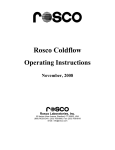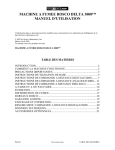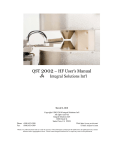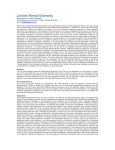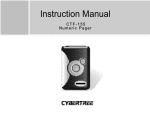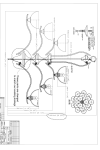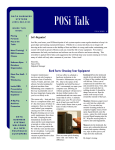Download DMX Iris Manual - Rosco Laboratories
Transcript
DMX IRIS Operations Manual DMX IRIS OPERATIONS MANUAL Introduction to your DMX Iris Features • 10mm – 75mm aperture range • 24 leaf mechanism for smooth-edged, truly round aperture projections • No external PSU required • 100-240 v compatible for use around the world • Unique friction lock holds unit securely in iris slot of luminaire • Manual control knob allows use without power or DMX In the Box (1) Rosco DMX Iris unit (1) NEMA/IEC power cord with u-ground type connector (1) Operations manual Set-Up and Installation Power Requirements The Rosco DMX Iris is equipped with an internal, auto-sensing power supply. It will automatically adjust and accept power input from 100 volts to 240 volts at a frequency range of 50 – 60 hz. Connect the included IEC power cord by firmly pushing it into the recessed socket on the DMX Iris. (Figure 1) When using the DMX Iris in regions using Figure 1 Power & DMX Connections p. 2 connectors other than a u-ground type, simply replace the connector or substitute the included IEC cable for one with the appropriate connector type. Make sure to use an IEC cable with at least 18 gauge conductors. Plug the connected power cord into a suitable non-dim or mains power supply. Do not connect the DMX Iris to a dimmer circuit unless the dimmer has been preset into a non-dim mode. The digital display will light when power is present. (Figure 2) Immediately after receiving power, the DMX Iris Unit may go through a homing cycle, ending in a full open or closed position of the iris. DMX Control To operate the DMX Iris from a DMX lighting console, you will need to connect a 5-pin DMX cable to the unit. The DMX Iris is equipped with two DMX ports, IN and OUT. (Figure 1) Connect the 5-pin DMX cable coming from your lighting console to the IN port. If your DMX chain continues beyond the DMX Iris, plug the next cable section into the OUT port. The DMX Iris may require an external DMX terminator to be installed in the OUT port if used at the end of your DMX chain. If no DMX signal is present, the digital display will indicate “LOST” and “512” in alternating sequence. If a DMX signal is present, the display will indicate both the operation Mode and the current DMX address of the Iris. (Figure 2) In this example, the DMX Iris is set to Mode 2 and DMX Address 001. Figure 2 Digital Display pad Configuring the DMX Iris The DMX Iris can be operated in one of four different modes, depending on the features and options desired. Modes 1 and 2 use one channel of DMX to control the DMX Iris. Modes 3 and 4 require two channels of DMX. p. 3 www.rosco.com DMX IRIS OPERATIONS MANUAL One Channel Operation Two Channel Operation (2nd Ch = speed) Mode 1: Open to Close (0-255) Mode 3: Ch 1 = Open to Close (0-255) Ch 2 = Speed (0-100%) Mode 2: Close to Open (0-255) Mode 4: Ch 1 = Close to Open (0-255) Ch 2 = Speed (0-100%) Setting DMX Address and Operation Mode On power up, the DMX Iris will restore to the last set mode and dmx address. The display will indicate these parameters as in Figure 2. To change Operation Modes, press and hold button B1 for a few seconds until the display changes to SET . Press B1 until the Left digit of the display display indicates the desired Mode 1, 2, 3, or 4. Use buttons B2 (100s), B3 (10s), and B4 (1s) to set the 3 digit DMX address of the unit. Press and hold B2 to SAVE the new settings. After saving new settings, the disply will indicate boot and then go into the homing sequence. To run a self-test mode, press and hold B4 A switch to the right of the display allows you to adjust the brightness of the display. Modes DMX Address 1. 0 0 1 Modes x100 x10 x1 B1 B2 B3 B4 Setup Save Test Installing the DMX Iris in your luminaire The DMX Iris has been designed to fit into most modern ellipsoidal luminaires. With its thin body design and customized toolings, the list of compatible fixtures includes ETC Source Four, ETC Source Four Zoom, Selecon Pacific, Altman Shakespeare, Strand SL, Leviton Leo and many p. 4 others. The Rosco DMX Iris is equipped with a unique safety feature, the Friction Lock. Located on the left side of the DMX Iris is the Lock Slider. Depressing this plunger will extend a knurled cylinder which presses against the insides of the accessory iris slot, securely holding the DMX Iris in place. To install the DMX Iris into your luminaire it is necessary that the Lock Slider be in the UP position, with the lock disengaged. Insert the DMX Iris into the iris slot of your luminaire with the motor box extending towards the front, the lens end, of the light. It may be necessary to angle the yoke of the luminaire back to allow access into the accessory iris slot. Note that on certain luminaires, the sliding cover of the iris slot may have to be removed to allow the DMX Iris to fit properly. Make sure that the DMX Iris is seated all the way down into the luminaire. This is is important to insure that the light path is not blocked. If you project an oblong or cut off beam pattern, wiggle and reseat the Iris all the way down. To engage the Friction Lock, press down on the Lock Slider until it stops. The unit will be held securely into the accessory iris slot. The Friction Lock is only intended to prevent accidental movement of the DMX Iris within the accessory slot. It is highly recommended that you install a safety cable (Figure 4) to prevent the DMX Iris from falling out of the fixture and possibly causing harm. Caution: Make sure to route the power cord and DMX cables to avoid the extremely hot back end of the luminaire. Failing to do so could result in melting cords, signal failure or fire!r Operation and Control DMX Operation Changing the level of the assigned DMX channel will cause the iris mechanism to open or close. You can define how the Rosco DMX Iris responds to DMX control signals. In Mode 1 and 3, a zero level of dmx sets the iris aperture to its full open 75mm aperature. Increasing the channel level or dmx value will close the DMX Iris until it reaches its smallest 10mm aperture. Switching the unit to Mode 2 or 4 reverses this behavior. As the level of the DMX channel increases, the aperture will iris up and when the level reaches 100% the aperture will be at its largest 75mm opening. Modes 3 and 4 are typically used with control consoles designed for automated moving lights and allow you to separately control the aperture size and movement speed on 2 differnt channels. p. 5 www.rosco.com DMX IRIS OPERATIONS MANUAL Manual Operation The Rosco DMX Iris can also be used as a manually adjustable iris in situations where live control of the aperture size is not required. With no power applied to the DMX Iris, turn the manual knob on the back of the DMX Iris until the desire aperture size is achieved. (Figure 4) If power is present, the manual knob cannot be used. Figure 4 Manual Control & Safety Cable Connection Precautions • Use only properly rated IEC power cord (18AWG 3C SJT) and connect only to compatible voltage supplies (100-240v 50-60hz) • Always use a safety cable to insure the DMX Iris cannot fall out of the fixture. • Do not allow power cords or DMX cables to come in contact with the body of the luminaire or the rear lamp cap. • Do not connect DMX Iris to a dimming circuit. • Keep fingers clear of moving iris mechanism. • The metal case of the DMX Iris may get very hot after continuous use in a luminaire. Use caution to avoid burns when handling units that have been in running luminaires. Troubleshooting 1. The DMX Iris will not fit into the Iris Slot. • Make sure the Friction Lock is in the up (disengaged) position and that the lock itself is not extending outside the metal case. • The iris slot cover of the luminaire may need to be removed to allow complete access to the slot. Fully remove the two screws holding the cover and lift off. Set aside so that the cover can be reinstalled at a later date. • Installing the DMX Iris into the Selecon Pacific Coolight requires that the guide channel in the side cut of the DMX Iris align with the rear guide track in the Pacific’s iris slot. • p. 6 2. The projected aperture appears out of round or cut off. • The DMX Iris is not properly seated in the luminaire. Remove Iris unit and reinsert making sure that the unit is seated all the way down in the light. 3. The manual control knob won’t turn. • 4. Make sure the DMX Iris is unplugged and no power is getting to the unit. The manual knob will not turn when power is present. Irregular or failed DMX Control • Check that the DMX Address is set properly. • Check that proper DMX signal is present (is the display flashing LOST / 512?) • If the DMX Iris is at the end of the DMX chain, connect a proper DMX terminator to the OUT port of the DMX Iris. Specifications Power Input 100 -240 v 50-60 hz, < 500 mA power draw Cord 18AWG 3C SJT, IEC/NEMA Connector Motor 24v 1.8° Stepper Type Aperature 10mm - 75mm Mechanism 24 leaf iris, bonded stainless steel Temp 450° C at iris leaves Made in Taiwan Copyright 2010 Rosco Laboratories Inc. p. 7 www.rosco.com www.rosco.com Rosco Laboratories, Inc. 52 Harbor View Ave., Stamford, CT 06902 (203) 708-8900 FAX(203) 708-8919 1265 Los Angeles St., Glendale, CA 91204 (818) 543-6700 FAX (818) 662-9470 Rosco Laboratories, Ltd. 1241 Denison St. #44, Markham, Ontario, Canada L3R 4B4 (905) 475-1400 FAX (905) 475-3351 Roscolab, Ltd. Blanchard Works, Kangley Bridge Rd., Sydenham, London SE26 5AQ England (20) 8659-2300 FAX (20) 8659-3153 Rosco Iberica SA C/Oro,76 Polígono Industrial Sur 28770 Colmenar Viejo, Madrid. Espana (34) 918 473 900 FAX (34) 918 463 634 Rosco do Brasil Ltda. Rua Antonio De Barros, 827, São Paulo SP Brasil CEP 03401-000 (11) 218-2865 FAX (11) 218-0193 Rosco Australia Pty Ltd. PO Box 873, Artarmon, NSW, 1570 42 Sawyer Lane, Artarmon, NSW, 2064, Australia (02) 9906-6262 FAX (02) 9906-3430












